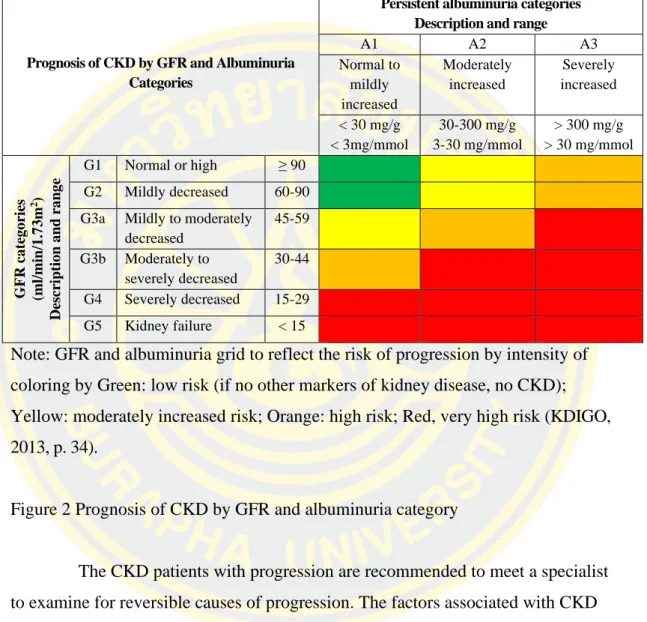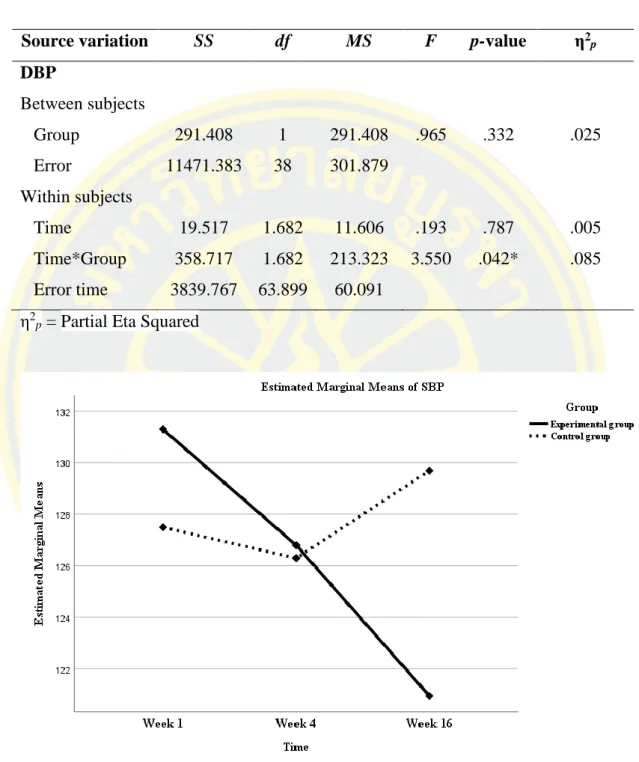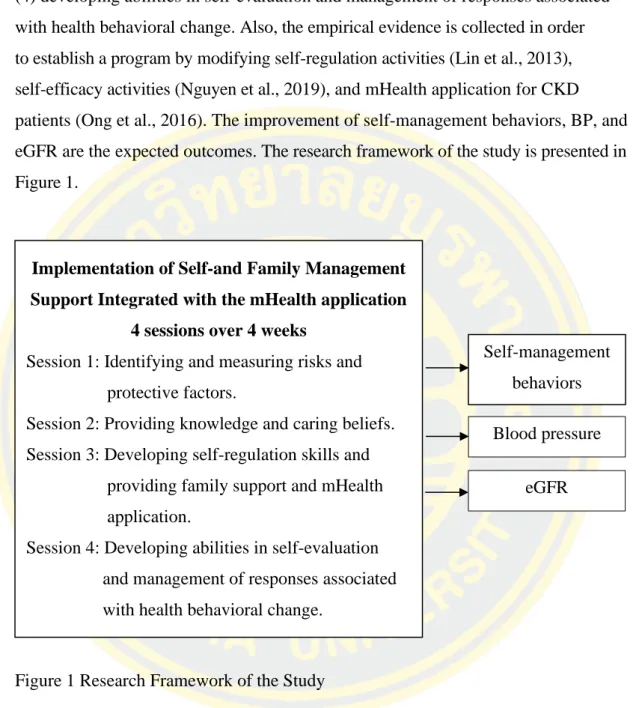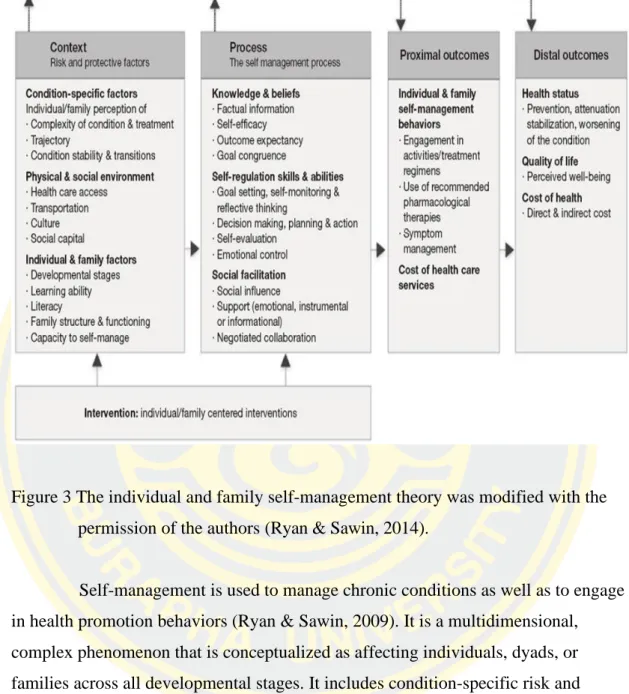Copyright © 2020 University of Būr Pha. EFFECTIVENESS OF SELF AND FAMILY MANAGEMENT SUPPORT COMBINED WITH THE MOBILE HEALTH APPLICATION PROGRAM AMONG PEOPLE WITH CHRONIC KIDNEY DISEASE STEP 3: A. A DISSERTATION PRESENTED IN PARTIAL FULFILLMENT OF THE PUBLICATION OF PHILO. This thesis has been approved by the Graduate School Burapha University in partial fulfillment of the requirements for the Doctor Degree of Philosophy (International Program) in Nursing Science of Burapha University.
Background and significance
The literature review found that the problem of chronic kidney disease patients in the early stage was a low level of self-management behavior (Sritarapipat et al., 2012) to a moderate level (Photharos, 2017). These respectful individuals may be family members with indirect effects on self-management behavior (Photharos et al., 2018).
Research Objectives
Also, most patients with stage 3 chronic kidney disease can develop into ESRD patients if they live without effective self-management behaviors. To compare the mean scores of self-management behavior and BP within the experimental group before the intervention (week 1), after the intervention (week 4), and the follow-up (week 16).
Research Hypotheses
Conceptual Framework of the Study
Therefore, the family is the center of care that enables patients to have proper self-management behavior and ongoing practice. It will develop knowledge and self-regulation skills and abilities, including higher self-efficacy leading to the ability to practice those behaviors and constant engagement in self-management.
Scope of the Research
The empirical evidence is also collected to establish a program by modifying self-regulation activities (Lin et al., 2013), self-efficacy activities (Nguyen et al., 2019) and mHealth application for CKD patients (Ong et al., 2019). , 2016).
Definition of Terms
Self-and family management support combined with the mHealth application refers to a set of activities provided for participants in the experimental
Self-management behaviors is defined as activities performed by
Estimated Glomerular Filtration Rate (eGFR) is a unit of plasma that flows from glomerulus into Bowman’s space over a specific period. It represents
Chronic kidney disease
- Definition of CKD
- Classification of CKD
- Etiology
- Pathophysiology
- Mechanism of glomerular impairment
- Mechanism of tubulointerstitial impairment
- Signs and symptoms
- Factors predicting the progression of CKD
- Management for slowing CKD progression
- Nutritional management
- Lifestyle modification
- Medical management
Thus, nutritional management of CKD patients is important to reduce the risk of CKD progression and complications, particularly by reducing protein, sodium, potassium, and phosphate intake. The result of a systematic review found that consumption of ≥ 15 packs per year increases the risk of CKD progression (Elihimas Júnior et al., 2014).

Self-management concept
Definitions of Self-management
The aim of disease management is to promote self-management by patients and to address diseases or conditions with maximum clinical outcome, effectiveness and efficiency (Schrijvers, 2009). Self-management is also described by WHO as one of the critical components in improving chronic care by focusing on supporting behavioral skills to manage conditions at home and includes obtaining necessary medications and medical equipment, self-monitoring tools and skills of self-management as. part of integrated care (Nuño et al., 2012).
Attributes of self-management
Schulman-Green et al. 2012) explains that self-management consists of three processes as follows (1) focusing on illness needs, (2) activation of resources and (3) living with a chronic illness, where tasks and competencies are delineated for each category. Most self-management definitions, skills, and tasks focus on individual self-management but do not involve family.
The Individual and Family Self-Management Theory
Context dimension
Family includes parents, siblings, spouse/partner and friends, which has significant potential to influence patients' self-management of chronic illness (Lee et al., 2017). Furthermore, family functioning has an indirect effect on self-management behavior among people with early-stage CKD (Photharos et al., 2018).
Process dimension
Self-efficacy is a behavior-specific concept and refers to the degree of an individual's self-confidence and ability to successfully engage in behavior in normal and stressful situations (Ryan & Sawin conducted a study on the effectiveness of self-management programs in people with stage CKD 3-5 focused on self-management, knowledge, self-efficacy, health-related quality of life and blood pressure. With regard to health-related quality of life, the physical and mental health components were significantly improved.
Outcome dimension
Family support enhancing CKD patient self-management
Spearman results showed a significant correlation (rs = 0.327, p < .001) between self-management and family function. Kendall Tau correlation coefficient analysis showed a significant correlation between self-management and family functioning of 0.24 (p < .001).
The mHealth applications for CKD management
- Definition of mHealth
- The application of mHealth
- The support of the Thai government to use mHealth
- mHealth applications that have been used in the literature on chronic disease, including CKD
The most commonly used applications for CKD patients are CKD information and CKD self-management (57%), e-consultation (25%), CKD nutrition education (24%), and eGFR calculators (19%). In conclusion, the mHealth application helps improve self-management behaviors, clinical parameters, and outcomes specific to CKD.
Outcomes of a self-management program among persons with CKD
Blood pressure (BP)
When blood pressure rises, factors such as sodium and potassium intake, physical fitness, alcohol, smoking, amphetamine, obesity, corticosteroid, non-steroidal anti-inflammatory drugs (NSAIDs) and herbs should be considered (Thai Hypertension Society, 2019; Whelton et al., 2017). There are some studies that found no significant improvement in blood pressure levels (Seephom et al., 2014).
Estimated Glomerular Filtration Rate (eGFR)
The normal value for eGFR is 90 ml/min/1.73 m2 and it is considered the best test to measure kidney function and determine the stage of kidney disease (NKF, 2019). One year is a proper period to measure an eGFR decline rate, and it is a good predictor of CKD prognosis (Nojima et al., 2017).
A Self-and family management support combined with the mHealth application program among persons with CKD stage 3
Elements and components of self-management support interventions All the included studies had a theoretical underpinning for their self-
The level of eGFR and its magnitude of change over time are critical for detecting kidney disease, understanding its severity, making decisions about diagnosis, prognosis and treatment, and screening for CKD progression.
Delivery characteristics
Duration of intervention delivery
This application consisted of six functionalities suitable for self-management among patients with CKD stage 3, as follows: (1) personal. The aim of this study was to investigate the effectiveness of self- and family management support combined with the mHealth application program on self-management behaviour, BP and eGFR among people with CKD stage 3.
Research Design
Population and Sample
Sample Size
Recruitment Procedures
Then, RA1 verified medical history records to recruit the potential participants who aligned with inclusion criteria. If the score of TMSE ≥ 23 points, it meant that the participants had no cognitive impairment.
Randomization Procedures
Next, the ability to use mobile apps and access the Internet was assessed, and family members who assumed the role of primary caregiver and could participate in the program were asked to participate.
Research Setting
The data management system of CKD patients favored the analysis of outcome indicators based on the criteria of the Nephrology Society of Thailand. Track eGFR, blood pressure, and blood sugar in CKD patient diaries.
Research Instruments
- The protocol of self-and family management supports combined with the mHealth application program for persons with CKD stage 3
- Worksheets
- VDO's media
- Home Blood Pressure Monitor (HBPM)
The SMBQ consisted of five dimensions of self-management behaviors with 37 items, including self-care activities (11 items), medication adherence (1 item). Additionally, the instrument was used in research on the effectiveness of self-management improvement programs for Thais with CKD in the predialysis stages by Suwanwaha et al.
Psychometric Properties of Research Instruments
Protection of Human Subjects
Pilot Study
Therefore, the researchers combined two and three sessions for the convenience of the participants and family. It was also beneficial for the participants and family members to be able to try the mHealth application longer and more proficiently.
Data Collection Procedures
The researchers conducted the program independently for the first week, spending about 30 minutes in a private room at the CKD clinic, Samut Prakan Hospital. The researchers and RA2 conducted the program in the second week on a small group of 10-12 people/group (participants of 5-6 people and family members of 5-6 people), spending approximately 60 minutes in a private room at the CKD. clinic, Samut Prakan Hospital.
The self-efficacy activity of Nguyen et al. 2019) was used in the program to increase confidence in managing CKD. This session aimed to provide a better understanding of the importance of CKD self-management and instructions on how to use the mHealth app to support self-management.
This session included three activities, including (1) demonstrating how to install the mHealth application named “Nyresund” and fill in username and password for registration, and how to use six functions of the mHealth application; (2) to allow the participants and their family members to try it by recording their laboratory results and BP in the application, communication with the health care provider via line worker; (3) return demonstration of how to use the mHealth application to the researchers, RA2 and IT experts after they had used the mHealth at home. Before entering the CKD clinic, the body temperature of participants, RAs and researchers must be checked.
Data Analyses
RESULTS RESULTS
CONSORT Flow Diagram
Figure 5 CONSORT flow diagram of the progression through the phases of a two-group parallel randomized trial (Schulz et al., 2010).
The demographic characteristics of the participants
Statistics showed no significant differences in participants' overall information between the two groups (p >.05). The general information of family members between the experimental and control groups in the pre-intervention period was compared with an independent t test and a chi-quad test.
Evaluations of statistical assumptions for the dependent variables
- Test for outliers
- Normality testing
- Homogeneity of variance (between-subject)
- Mauchly’s test of sphericity (within-subject)
Therefore, assumed sphericity was chosen to report the results of the repeated measures ANOVA in these aspects. Therefore, Greenhouse-Geisser was chosen to report the results of repeated measures ANOVA in these aspects.
Descriptive statistics of the outcome variables
In contrast, the value of SBP and DBP were significant (p < .05) indicating that the homogeneity of the variance-covariance matrices was not equal and the assumptions of sphericity were not met. Tables 7 Means and standard deviations of scores of self-management behaviors, SBP, and DBP, and eGFR at pre-intervention (week 1), post-intervention (week 4), and follow-up (week 16) for the experimental and control groups.
Comparisons of the pre-intervention score of outcome variables
Testing of research hypotheses
Comparisons of self-management behavior scores obtained from three-time measures in the experimental and control groups, as well as three-
Figures 6 Comparisons of self-management behavior scores between experimental and control groups during 3-time measurements. Tables 11 Simple effect of time on the results of self-management behavior in the experimental and control groups.
Comparisons of SBP and DBP scores obtained from three-time measures in the experimental and control groups, as well as three-time measures
Table 19 Comparisons of mean difference of DBP scores between each pair of time differences within the experimental group and the control group using Bonferroni-corrected paired t-test. Comparisons of eGFR scores obtained from two-time measurements in the experimental and control groups.

Comparisons of eGFR scores obtained from two-time measures in the experimental and control groups
Table 20 Comparison of an eGFR at follow-up (week 16) between the experimental group and the control group.
Conclusion of the findings
DISCUSSION DISCUSSION
This chapter was presented in five parts, namely a summary of the study, a discussion of the study results, strengths and weaknesses, suggestions and recommendations, and finally a conclusion.
Summary of the study
The results showed statistically significant differences in the interaction effects (time*group) as evidenced by the mean score of self-management behaviors, SBP and DBP. However, there was no significant difference in the mean eGFR score in the two groups during the follow-up period.
Discussion of the research findings
Mean self-management behavior and SBP scores in the experimental group were significantly higher than those in the pre-intervention period (Week 1). This hypothesis was supported by the difference in the mean self-management behavior score at week 16 compared to week 1.
Strength and limitation
More importantly, this study also found that clinical outcomes could be further improved by combining mHealth with family caregiver support, rather than using an mHealth intervention alone. According to the analytical results, the mHealth intervention could be used as a treatment strategy to optimize the effective management of hypertension and CLB.
Suggestions and recommendations
Conclusion
Effects of a self-management program in patients with early chronic kidney disease: a pilot study. A structural equation model of self-management behavior among patients with early stages of chronic kidney disease [Unpublished doctoral dissertation].
APPENDICES
รายนามผู้ทรงคุณวุฒิ
คณะพยาบาลศาสตร์ มหาวิทยาลัยมหิดล
แบบทดสอบสมรรถภาพทางสมองของไทย The Thai mental state examination (TMSE )
Orientation (6 คะแนน)
แบบสอบถามข้อมูลส่วนบุคคล
The demographic data record form
การใช้อุปกรณ์เทคโนโลยี
แบบสอบถามพฤติกรรมการจัดการตนเอง
Self-care (กิจกรรมการดูแลตนเอง)
ได้ไปตรวจตามก าหนดเวลานัดของโรงพยาบาล
แอพพลิเคชั่นสุขภาพมือถือ Mobile Health Application
4 3 ผู้วิจัยรายบุคคล30นาท ระยะทดลอง
ปัจจัยเฉพาะโรค 2) ปัจจัยด้านกายภาพและ
งเป
เอกสารแสดงความยินยอม
ของผู้เข้าร่วมโครงการวิจัย (Consent Form)
ส าหรับกลุ่มทดลอง)
ส าหรับกลุ่มควบคุม)
Test assumptions
- Univariate outlier of the variables
- Normality of distribution
- Homogeneity
- Assumption of sphericity (within-subject) 1 Mauchly's test of sphericity a
Tests the null hypothesis that the error variance of the dependent variable is equal across groups. Tests the null hypothesis that the error covariance matrix of the orthonormalized transformed dependent variables is proportional to an identity matrix.
BIOGRAPHY

